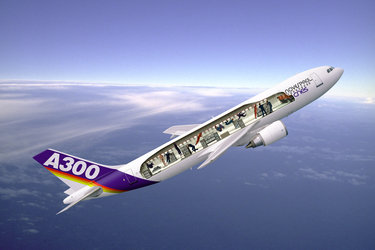Lose weight fast the ESA way!
Lots of us want to lose some weight – but just take your seat on one very special aircraft and you will soon weigh 100% less – guaranteed! That fact makes a flight on ESA's 'Zero-G' A-300 Airbus a valuable asset for scientists across Europe, and ESA also gives European students a chance to fly.
Every year 120 students studying in ESA member states win the opportunity to take part in a dedicated student parabolic flight campaign, by submitting microgravity-based experiment proposals to the Agency. The next campaign is scheduled for July 2004, with proposals due by 12 January. And if you want to know what the experience really feels like – read on!
First hand report from zero-g

Through the aircraft window I watch probably one of the more alarming sights to be seen on any ordinary flight: a wing flexing as my plane tilts down towards the surface of the Atlantic.
Although the fact that I am floating in my seat as I observe this demonstrates that this is no ordinary flight and the Airbus is no ordinary aircraft. This is the final day of the 35th ESA Parabolic Flight Campaign, providing professional European researchers with access to microgravity – 20 seconds per parabola flown.
Everything is under control. As the pilots finally start righting the aircraft a view of the sky replaces the sea – and I bump back on my seat as Zero-G is replaced by gravity close to double that on Earth.
The A-300 has been specially customised for parabolic flights. For practical reasons it lacks a bathroom, although the 12 teams aboard are far too focused on their experiments - all specifically designed to take advantage of the weightless environment - to really notice.
Pilot’s eye view
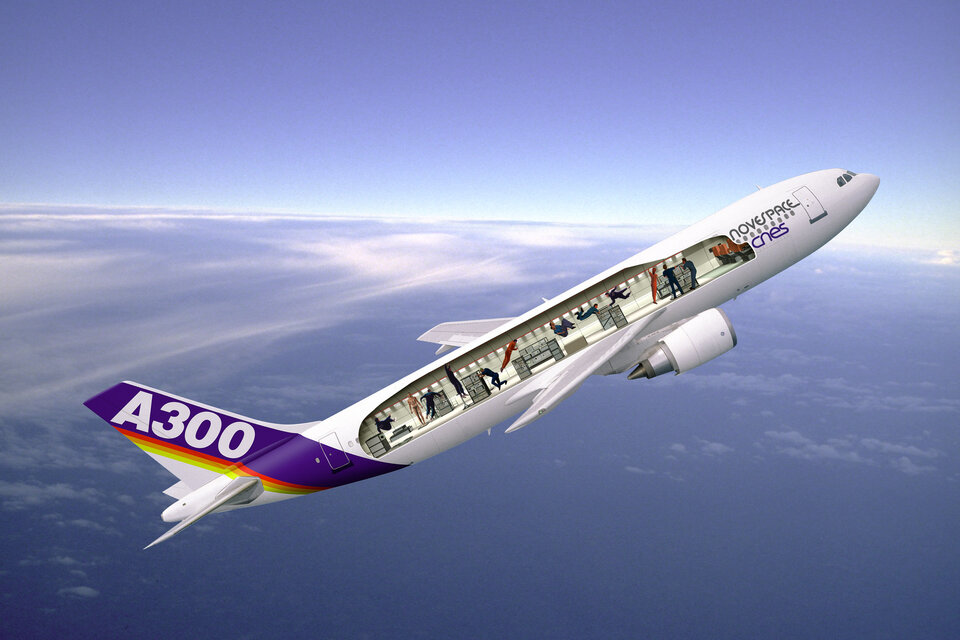
Joining the three pilots in the A-300 cockpit makes for an even more startling view. As they tilt the aircraft upwards to an angle of 47 degrees the sky turns a strikingly deep blue and all sight of the ground is lost. The force of the engines combined with gravity makes me sink into my seat, until suddenly Captain Gilles Le Barzic announces ‘injection!’ and the 20-second period of weightlessness begins.
The aircraft traces a parabola through the air and a brief swirl of clouds can be seen before we are facing more dark blue. It is only the white breakers that make me realise that it is the sea that now fills the cockpit windows. The next announcement comes: ‘pull out!’ followed by the 20-second period of 1.8G before one minute’s normality before the next parabola begins.
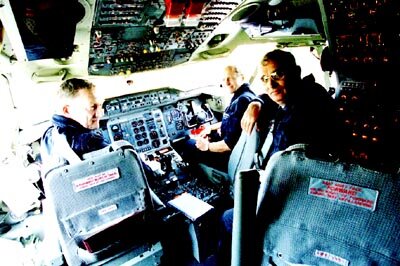
Moving back into the main white-padded cabin, most of the space is taken up by 12 different experiment rigs fastened to the floor. Researchers are kept busy tending to the experiments and fastening themselves to red cords in expectation of the next bout of weightlessness, because otherwise the slightest exertion might send them flying up towards the ceiling. Isaac Newton put it best: ‘For every action there is an equal and opposite reaction’.
Free floating in the cabin is banned for safety reasons – not least because when the double gravity arrives you would hit the ground very hard indeed. But there is a netted-off area where flying is allowed – nicknamed the ‘monkey house’.
Waiting for weightlessness

It is here in the netted-off area that I lay down in preparation for my very first parabola. In double gravity I keep very still, because moving your head in these conditions can cause nausea. The feeling is reminiscent of fairground spin-rides, but much more powerful, and the flesh on my face seems to wobble. Then comes the call ‘injection!’ over the cabin intercom and everything changes.
If zero-gravity feels like anything previously experienced it might be a little like the split-second floating feeling you get driving over a bump at high speed. Except it goes on, and on, and on…
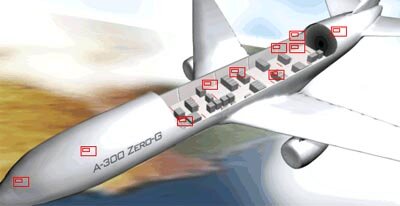
As I start to float the first instinctive reaction is one of panic and I start to flail my limbs around as if I was drowning. But this just sends me up from the ground all the faster. I realise I have to start taking Newton’s advice and make my limbs relax. I gently push myself off the ceiling to start myself floating down again and grab a drifting safety cord to right myself again well before the double gravity phase.
By the time the next parabola comes round I am excitedly anticipating the experience. Second time around I am sitting in a lotus position and a single tap of my finger sends me into the air. An ‘orange angel’ flight attendant – named for the colour of their suits – sets me gently spinning around.
Workout time
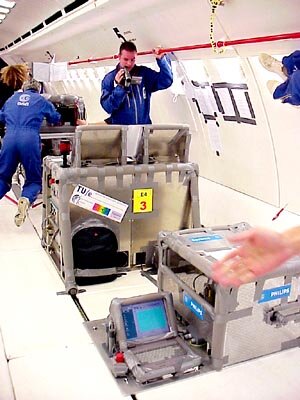
Whether the gravity is normal, high or non-existent the dozen busy experiment teams aboard keep on working hard, using safety cords to keep themselves close by their equipment rigs. As with every parabolic flight, researchers have come from far and wide to take up the opportunity – from all across Europe and as far away as Canada.
Professor Maurice Hinsenkamp from the University of Brussels in Belgium is one of only a two-man team, assessing equipment designed to measure the stress loading on astronauts' bones in real time. The lack of stress on astronauts' weight-bearing bones during long duration space missions can lead to permanent bone mass depletion, but the phenomenon must be better understood before countermeasures can be developed.
Meanwhile a ten-strong group of researchers from Eindhoven and electronics firm Philips are busy monitoring what happens to high-intensity metal halide bulbs as the gravity shifts. And a team from the University of Paris Sud is assessing equipment to manufacture foams in weightlessness, finalising the design of a foam-making machine intended for future flight aboard the International Space Station.

Also destined for ISS is an innovative Flywheel Resistive Exercise Device developed by ESA with the Karolinska Institute in Stockholm, Sweden. It works on the same principle as a yo-yo to give astronauts a strenuous workout even in the absence of gravity.
A-300 co-pilot and ESA astronaut Philippe Perrin took time out from the cockpit to try out the Device, giving the design team the benefit of his experience on a Shuttle mission last year.
Eye-spy

Other than the flight crew, everyone on this aircraft is either an experimenter or a test subject. I fit into the second category and for the second half of the flight earn my passage by being strapped into a chair with my fingertips covered with thick plastic and an unwieldy eye-tracking helmet on my head. My job is to repeatedly move a disc fitted with light emitting diodes through a figure of eight, watched all the while by a bank of video cameras.
The disc gets pretty heavy in double gravity but I keep it going, just about. It becomes easier for the last set of parabolas, when the plastic is removed from my fingertips.
A team from Belgium’s University of Louvain and Canada’s Montreal University set up the experiment to investigate the roles played by sight and sensory feedback in maintaining a grip on objects in different gravities.

“It takes some pretty high-level brain functioning just to pick things up and manipulate them,” explains Professor Allan Smith of Montreal University. “You have an example of it when you pick up a carton of milk without knowing it is almost empty. It shoots up in your hand, but the adjustment to the correct force needed is quick.
“Knowing how this ability works could have multiple uses, including improving therapy for patients with loss of limb sensitivity and improving telerobotics systems.”
Weightlessness seems to pass slowly, but the overall sickness-free flight time went all too quickly and the A-300 came down shortly before 13:00. The 12 teams expressed their satisfaction, then started to dismantle their equipment before going their separate ways across Europe.
To find out more details about how you could potentially carry out your own microgravity experiments during next July's student parabolic flight campaign, visit http://www.estec.esa.nl/outreach/parabolic/





